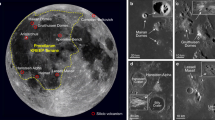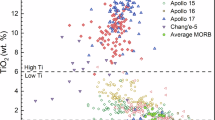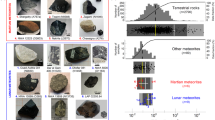Abstract
MEASUREMENT of the temperature of the Moon is generally done by absolute radiometry assuming the emissivity of the lunar surface to be independent of wave-length and to be that of a ‘black-body’, namely, ε = 1.00, and calculating the temperature from Stefan's law1. This ‘black-body’ assumption is based on the 1930 interpretations of Pettit and Nicholson2 of radiometric data they obtained with crude filter monochromators. The basis of these deductions was that the ratio of the radiant energy between 8–10µ to the radiant energy between 8–14µ observed was nearly identical to the ratio calculated for a ‘black-body’ at 400° K. The temperature of the sub-solar point (400° K) was calculated in the usual manner (assuming the emissivity to be unity) after relating all the measurements to the radiometric magnitude of a comparison star. From these paradoxical assumptions they concluded that the emissivity of the lunar surface in the region 8–10µ is unity and is unaffected by the restrahlen of any silica content it may have; this is contrary to observations made on the emissivity of silica or silicates3,4. In order to reconcile this dissimilarity with their original conclusion Pettit and Nicholson decided the lunar crust was finely divided, like sand, or porous, like pumice, and that its radiating properties would therefore be nearly those of a ‘black-body’.
This is a preview of subscription content, access via your institution
Access options
Subscribe to this journal
Receive 51 print issues and online access
$199.00 per year
only $3.90 per issue
Buy this article
- Purchase on SpringerLink
- Instant access to full article PDF
Prices may be subject to local taxes which are calculated during checkout
Similar content being viewed by others
References
Pettit, E., in The Solar System, 3, Planets and Satellites, 400 (Univ. Chicago Press, 1961).
Pettit, E., and Nicholson, S. B., Astrophys. J., 71, 102 (1930).
McMahon, H. O., J. Amer. Cer. Soc., 34, 91 (1951).
Wood, R. W., Physical Optics, third ed. (Macmillan and Co., New York, 1934).
Sloan, R., Shaw, J. H., and Williams, D., J. Opt. Soc. Amer., 45, 455 (1955).
Burns, E. A., and Lyon, R. J. P. (to be published).
Shorthill, R. W., and Saari, J. M., Boeing Aircraft Co., Rep. (Jan. 30, 1961) under Air Force Contract 18600-1824.
Bell, E. E., and Eisner, I. L., J. Opt. Soc. Amer., 46, 303 (1956).
Bell, E. E., Eisner, I. L., Young, J. B., Abolins, A., and Oetjen, R. A., Ohio State Res. Found., Final Eng. Rep., Contract 33(616)3312.
Author information
Authors and Affiliations
Rights and permissions
About this article
Cite this article
BURNS, E., LYON, R. Errors in the Measurement of the Temperature of the Moon. Nature 196, 463–464 (1962). https://doi.org/10.1038/196463a0
Issue date:
DOI: https://doi.org/10.1038/196463a0



